Sailing
![]()
The title of this article is ambiguous. For other meanings, see Sailing (disambiguation).
Sailing is the movement of a sailing ship or sailboat using wind energy. For many centuries, sailing ships were of great importance worldwide for trade and transport, warfare and fishing. Towards the end of the 19th century, they began to be displaced by machine-powered ships, which were less dependent on weather conditions and allowed for shorter journey times, fewer personnel and thus falling transport costs.
Today, sailing in industrialized countries is almost exclusively a recreational or competitive sport, although navies and merchant marines continue to maintain sail training vessels for the education of their young. In other, less developed regions, however, sailing ships have been able to retain their economic importance to some extent to this day. From the Persian Gulf, for example, dhow ships carry loads to India and Africa, just as they did hundreds of years ago.
In the course of time, sailing ships have developed in many different designs and sizes, whereby a basic distinction can be made between displacement boats (mostly larger and heavier ships) and planing boats (mostly small, light and fast boats). The range extends from the one-person dinghy to yachts and catamarans to the large sailer with a crew of several dozen. A variety of sailing manoeuvres have developed for the different types of boats, which are brought to perfection in sporting competitions. For this, a basic understanding of the structure of the ship and the physical principles of sailing is helpful. Depending on the size of the ship and the sailing area, sailing also requires basic seamanship skills and knowledge of various legal regulations and conventions.

Modern 49-foot cruising yacht

Training ship Alexander von Humboldt
History
See also: History of the development of the sailing ship, History of seafaring, Roman navy, History of Viking shipbuilding.
Ancient
The first known depiction of a ship with a sail can be found on an Egyptian funerary urn from Luxor dating back to 5000 BC. The Egyptians used ships with a mast and a large square sail primarily for travel on the Nile, but also for voyages across the Mediterranean and the Red Sea. The sail was already rotatable, so that the ships could also sail in sideways winds.
In the South China Sea, outrigger canoes were developed around 3000 BC and used for the settlement of Polynesia. Further developments of these multihulls, such as pirogues and proas, are still used today in regatta sports or as commercial vehicles.
The Phoenicians and Greeks developed two basic types of seagoing sailing ships from around 1000 BC: the cargo ship with a spacious hull and a large square sail, and the galley, which had a mast with a medium-sized square sail for cruising, but was rowed with oars during a sea battle and in the doldrums.
In the following centuries, sailing ships were used for numerous voyages of discovery and conquest. For example, the Greek historian Herodotus reports of the Egyptian pharaoh Necho II, who initiated a first circumnavigation of Africa (clockwise) by Phoenician sailors in 596-594 BC. Around 508 BC, the Greek geographer Scylax undertook a voyage of discovery from the mouth of the Indus River to the Arabian Gulf and further around the Arabian Peninsula to the Red Sea and Egypt. Around 470 BC, the Carthaginian ruler and admiral Hanno the Navigator sailed westward from Carthage, through the Strait of Gibraltar along the west coast of Africa to the Gulf of Guinea. His periplus (voyage report) has survived within a Greek manuscript of the Codex Palatinus Graecus. The Greek navigator Eudoxos from Cyzicus undertook an exploratory voyage to India between 120 and 117 BC and recognised the importance of the monsoon winds for sailing in the Indian Ocean.
Around the turn of the century, the Romans also used combined rowing and sailing ships for war and trade purposes. The bowsprit as part of the rigging is regarded as a significant further development of this period. With the expansion of trade between Syria and Italy with goods from the Far East, attacks by pirates on merchant ships also increased sharply. In 102 BC, the plague of Cilician and Cretan pirates became so bad that Rome decided to take countermeasures. The orator Marcus Antonius the Elder undertook a campaign against Cilicia, but with only moderate success. The Roman fleet had at all times of the Roman Empire a comparatively small importance in relation to the importance of the land army.
Viking Age and Middle Ages
The Saxons and Angles, who migrated across the North Sea to England as Anglo-Saxons towards the end of the Roman Empire, had longships with a mast and a square sail. The Vikings perfected this type of ship from the 6th century to the 8th century. The development of a functional rigging was the most significant technical advance in shipbuilding. In combination with the slender, double-ended ship type, Viking ships could reach speeds of up to 20 knots (37 km/h).
After the end of the Viking Age, the Hanseatic cog was developed in the north from the wider, open trading ships. It had only one mast and formed the backbone of the Hanseatic League's long-distance trade. Towards the end of the Middle Ages, two- and three-masted ships were also built. From these, the caravel was developed in Spain and Portugal, with which Christopher Columbus, Ferdinand Magellan and Vasco da Gama undertook their voyages of discovery. At the beginning of the 15th century, the Chinese admiral Zheng He undertook numerous sea voyages in the Indian Ocean as far as East Africa.
Modern Times
From the 17th century onwards, increasingly specialised forms were used, including ships of the line (as warships with several gun decks) and frigates (lighter-armed ships of increased speed). Shipbuilders developed increasingly sophisticated sails. Ships became slimmer, had more draft, and could be sailed higher and higher on the wind. The increase in merchant shipping in the 19th century brought the fast sleek clippers that reached average speeds of up to 18 knots.
The use of iron (from around 1890 steel) as a boat-building material heralded the age of the great windjammers. In 1902 and 1911 respectively, the Prussia and the France, the largest sailing ships of all time, were launched. At the same time, however, sailing ships were increasingly replaced by the more manoeuvrable and economical steam and later motor ships. Today, sailing ships in the industrialized nations are almost only used as training ships or sport boats. The largest sailing ship in operation today is the Royal Clipper, which serves as a luxury cruise ship.
For recreational pleasure, sailing boats were used on a larger scale from the beginning of the 18th century, especially at court and by wealthy businessmen in England and the Netherlands. In 1720, the first yacht club was founded in Cork, Ireland, and in 1749 the Prince of Wales started the first regatta in which a cup was at stake. In the second half of the 19th century, several important sailing regattas were established, such as the America's Cup in 1851 and the Kieler Woche in 1882. The first sailing club in Germany was founded in 1835 under the name of Tavernen-Gesellschaft in Stralau (since 1920 a district of Berlin), but did not last long. The oldest existing German sailing club, the Segelclub Rhe, was founded in Königsberg in 1855. In 1900, the first Olympic competition in sailing took place. While sailing started out as an elite sport for rich people for cost reasons, it has since increasingly developed into a popular sport.
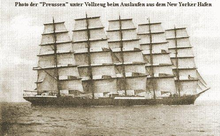
The Prussia (photograph from 1908), after the France the largest sailing ship ever built
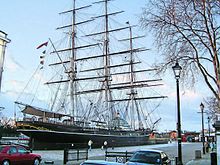
The Cutty Sark (1869), one of the last tea clippers
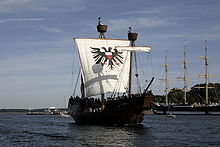
Replica of a Kraweel, a type of Hanseatic ship from the 15th century
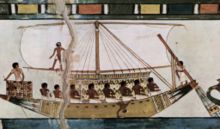
Egyptian sailing ship (mural c. 1422-1411 BC)
Parts of a sailing ship
See also: Parts of a sailing yacht
Regardless of its size, every sailing vessel consists of three major assemblies: one or more hulls, the sails, and the rig.
The hull can be made of steel, aluminium, glass fibre reinforced plastic (GRP), concrete or wood. Vessels with one hull (yachts and dinghies) are also called "monohulls", in contrast to proas, catamarans and trimarans, which consist of two or three parallel hulls joined together and are called "multihulls". The hull usually carries on its underside a fin permanently attached to the hull - the keel or centreboard, which is mainly variable in depth. These components are intended to reduce the drift (drifting) of the ship in sideways winds (see Hull Shapes and Stability) or to ensure the stability of the ship in sideways conditions (heeling). Furthermore, on the underside of the hull or, in smaller boats, at its end, is the rudder or, rarely, the rudder. It is connected on deck with a tiller or with a steering wheel, with which the boat is steered.
Sails are generally divided into square sails and square rigged sails. Square sails are the sails that stand at right angles to the midship's plane and are therefore particularly suitable for sailing with the wind from behind (aft wind). For sailing diagonally against the wind, however, they are, in relation to square sails, only capable of large turning angles. They are therefore no longer or only rarely used today, with the exception of traditional ships.
In contrast, the fore-and-aft sails, which are attached to the mast with their leading edge (luff) in the midship plane, for example, also allow the ship to sail diagonally against the wind (on the wind). There are even finer subdivisions according to the shape of the sail, e.g. lateen sails, lugger sails, spritsails, gaff sails and high sails.
A modern bermudarig can reach a course of up to 30 degrees with up to 0 degrees of drift, a classic Schratrigg a course of 45 to 50 degrees with a drift of about 5 degrees and a Rahrigg can reach courses to the wind of about 60 degrees with 10-15 degrees of drift.
The large, bulbous, usually colorful spinnaker, also simply called "spi", occupies a special position, as it can be assigned neither to the group of square sails nor to the group of square rigged sails. It is held only at its three corners and is mainly used to provide a large attack surface for aft winds.
In the past, cotton was used as the sail material. Today it has been largely replaced by polyester fabric, and in modern regatta boats also by aramid fibre fabric (trade name Kevlar) or laminates.
Rigging (sometimes called rigging) includes the mast and boom, as well as the standing rigging and the running rigging. In this context, rigging means as much as cordage. The standing rigging is almost always made of steel wire and supports the mast. It includes, among other things, the stays that hold the mast forward and aft, and the shrouds that give it lateral support. Running rigging is all rigging on the ship that is used to adjust the sails. In particular, this includes halyards, which are used to set and furl sails, and sheets, which are used to change the angle of the sails to the wind. Depending on the type of rigging, ships have one (slup, cutter) or more masts (yawl, ketch, schooner), each with one or more sails.
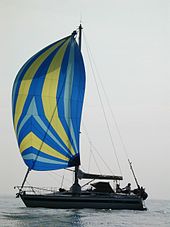
Sailing yacht under spinnaker
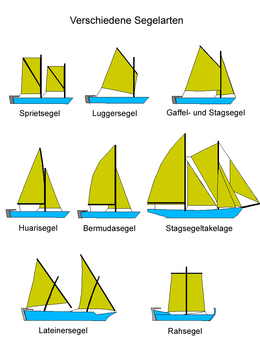
Questions and Answers
Q: What is sailing?
A: Sailing is the act of controlling a boat using the force of the wind.
Q: What was the importance of sailing boats in the past?
A: Sailing boats were very important for transportation of cargo and people.
Q: What replaced sailing boats in the late 19th century?
A: Boats that used steam to generate motion gradually replaced sailing boats starting at the end of the 19th century.
Q: Is sailing still important in some regions of the world?
A: Yes, in some regions of the world, sailing vessels still hold great importance.
Q: Do military forces use sailing vessels?
A: Yes, many military forces have sailing vessels for the purpose of training.
Q: Is sailing a hobby for some people?
A: Yes, sailing is a hobby for some people.
Q: Is sailing a competitive sport?
A: Yes, sailing is a competitive sport and is played in the Olympic Games.
Search within the encyclopedia